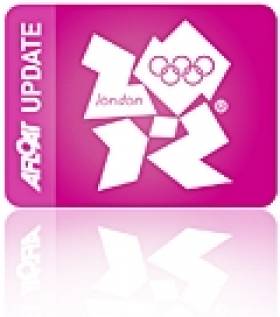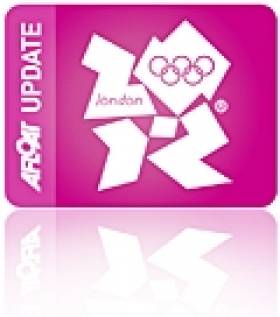Displaying items by tag: Laser
Espey Reigns Supreme as Irish Laser Class Champion
#laser – The VonZipper Laser National Championships under International Race Officer Con Murphy concluded on Dublin Bay yesterday with two final races in a stiff SE'ly sea breeze. In the Standard (Full) rig class, Irish London Olympic Men's Single handed representative James Espey of Ballyholme YC narrowly beat Annalise Murphy of the host club who, sailing the full rig for the first time, had a great event with four race wins and three seconds.
The two London Olympians sailed neck in neck up to the final race and gave the spectators and fellow sailors a great display of superb competition. Mattie O'Dowd of the RSGYC finished in third place with Chris Penny of East Antrim in fourth and Cork's Nick Walsh the first Master.
In the Radial class, the battle of the 'Darraghs' from Cork saw Darragh O'Sullivan from Kinsale take the title ahead of Baltimores Darragh Mc Cormack. Dan O'Beirne of the RSGYC took third and Suzanne Flanigan of Ballyholme took the Ladies Championship.
Mark Hassett of Schull SC comfortably won the 4.7 Championships with a 17 point lead over second place Richard Maher from Perth, Australia. 6 points behind in third was Conor O Beirne from the RSGYC followed by the first girl in the fleet Sorcha Ni Shuilleabhain from Kinsale.
The championships, sponsored by Dalkey Optician Paul Gill, was deemed a great success with excellent racing conditions and the Parade of Tall ships and fleet of spectator boats giving a fantastic backdrop on the final day. Full results below.
#laser – A highlight of the Laser class National championships at the National Yacht Club in Dun Laoghaire has to be Annalise Murphy's performance in her first event ever sailing the bigger standard rig as opposed to her usual Radial rig with two race wins yesterday in the tough conditions. The event has seen some great racing between five Olympians in the standard rig. The event sponsored by VonZipper sunglasses have reached their half way stage on Dublin Bay yesterday with 6 races completed by the standard rigs and 5 by the Radial and 4.7 classes.
Being run over 4 days this week by the National Yacht Club in Dun Laoghaire, the large entry includes 4 of the Irish London Olympic Sailing Team - Laser men's representative James Espey, Laser Women's helm Annalise Murphy, 49er Helm Ryan Seaton and 470 crew Scott Flanagan - and Volvo round the world race officer Bill O Hara all in the Standard rig class. The opening day on Thursday saw light southerly and shifty winds and Friday gave excellent racing with a 15 knot steady easterly breeze. The 4 Olympians have dominated the first 2 days along with local sailor Mattie O'Dowd.
The event continues today and Sunday with five more races scheduled. Results available here. Laser National Championship photos are here.
#laser – London Olympian Annalise Murphy who scored Ireland's top Olympic sailing result for 32 years earlier this month in Weymouth made a welcome return to her home waters of Dublin Bay yesterday to compete in the first race of the Irish Laser National Championships hosted by her home club the National Yacht Club. Scroll down for the first day's action captured by photographer Aidan Tarbett.
Sailors Welcomed to NYC for Irish Laser Nationals
#LASER - The Irish Laser National Championships begin today in Dun Laoghaire running till Sunday 26 August, and the National Yacht Club has posted all the details Laser sailors will need regarding their visit for the weekend's competition.
Aside from the parking and event info are the all-important social arrangements for competing sailors, kicking off with a welcome barbecue after today's racing with a selection of burgers, spit roast and chicken. Tickets are €10 and available at registration.
Tomorrow will see the NYC AGM at 5pm after the racing in the JB Room, followed at 6.30pm with a special reception for Laser Radial Olympian Annalise Murphy - not to mention soup and rolls for the hungry sailors after their day on the water.
On Saturday the fleet will be treated to a pasta dish coming off the water, followed by a Tall Ships farewell evening in the Docklands. And Sunday's post-competition activities include the prizegiving ceremony and a farewell barbecue.
Full details for Laser sailors are available on the National Yacht Club website HERE.
Laser Espey in 28th and Irish 470 25th at Weymouth
#laser #470 – Irish Laser sailor James Espey struggles to some good mid race positions in the largest of the Olympic fleets. Espey had a 28th in Race 7, at one point reaching 19th in the fleet. He also climbed during Race 8 fluctuating between 12th and 15th for the first half but ultimately crossed the line in 27th only two minutes behind the leader. Espey moves up seven places to 38th overall and will sail his final two races tomorrow, a medal race position is not a possibility.
The 470 duo, Ger Owens and Scott Flanigan had a further two races today. The pair had a 24th and 25th leaving them 25th overall after four races. They continue this today.
Sailing action starts at 12 noon in Weymouth.
Laser Leinster Sailing Titles Go To Three Provinces
#lasersailing – Consistency was certainly the key to success in the Laser Leinster Championships at Howth over the weekend, with the winners in the Standard, Radial and 4.7 rigs showing impressive form in varying wind conditions to take the titles to the north, east and south coasts respectively.
With the exception of an OCS in the second race, East Antrim's Chris Penney rattled off a series of four second places and one bullet to win the 22-boat Standard Rig division by a clear four points from the early pace-setter, Alan Ruigrok from Rush, who was comfortably ahead of third-placed Ronan Cull of Howth.
The Radial rigs only got five races sailed, and despite a hat-trick of race wins on the first day, Ballyholme's Christopher Eames had a poorer second day, allowing the more consistent Finn Lynch of the National Yacht Club to head the 36-boat fleet and win overall. His worst result was a fourth so he won by a clear six points after discards.
The most outstanding performance of the weekend was by Mark Hassett of Baltimore SC who notched up four race wins and discarded a DNC to top the 20-boat division. At any other time, Conor O'Beirne (Royal St.George YC) might have won the event with a string of top three finishes but had to settle for the runner-up spot on this occasion.
Annalise 16th at Laser Radial Worlds in Germany
#LASER RADIAL WORLDS – Annalise Murphy's 64th and 33rd scored yesterday in the penultimate day of racing at the Laser Radial World Championships in Germany put her 16th overall with overall scores tighenting significantly at the top of the table.
This season's most consistent sailor, with three World Cup wins under her belt Lijia Xu (CHN) had her worst day of this Boltenhagen regatta with light winds saddling her with a 14th and 12th, these are now her two discards.
However Xu is still ahead of Gintare Scheidt (LTU) in the overall results due to her 12–point lead with which she went into today's races.
The final rounds will be sailed today and there is no medal race in this world championship format.
Yesterday's first start at the Audi Laser World Championship 2012 was postponed for three hours as there was barely any wind. Around 1pm a sea breeze came in and there were six to eight knots for the first race and ten to twelve knots for the second. A small current on the Wohlenberger Wiek kept the sailors in line and there was neither a general recall nor a single early starter during any of the starts.
Although for Lijia Xu (CHN) the racing did not go as smoothly as on previous days she is still ahead of Gintare Scheidt (LTU) in the overall results due to her 12 point lead with which she went into today's races. Scheidt convinced in the first race where she was second but had to discard the sixteenth place from the second race as her worst result in the final series so far. With the second discard after ten races Alison Young (GBR) only adds one point to her overall score and moves back up into third place.
Sari Multala (FIN) slips to fourth place but with only eleven points separating her and Lijia Xu in first place there is still the possibility for some major changes in the overall rankings. Defending World Champion Marit Bouwmeester (NED) is keeping steady in fifth place overall with two ninth places. 18-year-old newcomer Erika Reineke (USA) scored spectacular results in gold fleet today, achieving a third and a first place ahead of fellow countrywoman Paige Railey who finished 20th and ninth.
Reineke is still ahead in the U21 rankings as well, having established a 69 point lead on Brenda Bowskill (CAN) in second place. Michelle Broekhuizen (NED) is in third place.
Sailor Tiffany Brien Crowned Miss Northern Ireland
#MISS NORTHERN IRELAND – Royal North of Ireland YC dinghy sailor Tiffany Brien is on her way to the Miss World Competition in China having won the 2012 Miss Northern Ireland competition in Belfast this week. One of Ireland's top Laser Radial sailors, Tiffany was crowned at a 'glittering' ceremony at the Europa Hotel in Belfast on Monday night.
Tiffany jets off to the Miss World final in China on Saturday August 18, more or less the same time as she had been planning to represent Ireland at the Olympics until Dublin's Annalise Murphy took the top Irish slot. The Belfast Telegraph has more on the story here. But Tiffany is still sailing though and as well as national Laser Radial honours Miss Northern Ireland will be sailing across the Irish sea to help fellow sailor, blind adventurer Mark Pollock who is recovering from a fall. The pair are to sail across the Irish sea together for a number of charities.
Tiffany, daughter of well know Belfast lough sailor Simon Brien, will compete against over 100 girls from round the world, including, Miss Ireland, Rebecca Maguire, who is also from Belfast.
More photos of Tiffany's Miss Northern Ireland success here.
#OLYMPIC SAILING – London Olympic debutante Annalise Murphy (22) who the Irish Sailing Association (ISA) say can be an Olympic medal winner in Weymouth this summer has had a 'difficult start' to her Laser Radial World Championships in Germany today as extremely shifty winds that increased from eight to twenty knots during the afternoon made racing difficult. Writing on her facebook page last night the UCD Science student told friends: "Tough first day on the water today. #onlyupfromhere!"
In the first race of the Audi sponsored event there was little or no beating in the first leg as the massive 133-boat fleet negotiated big wind shifts. Annalise finished 65th and more problems followed in race two when a collision forced the Dun Laoghaire sailor into a 720 degree penalty turn leaving her 33rd and 103rd overall.
Results sheet is downloadable below as a PDF.
Both starting line and race course had to be repositioned several times and mixed results for the entire fleet reflected the tricky conditions.
Cecilia Carranza Saroli from Argentina achieved the most consistent results with a fifth and a first place. In second place after two qualifying races is Tatiana Drozdovskaya from Belarus with a sixth and a second place. She is followed by Finland's Sari Multala who won the first race and placed eighth in the second.
Favourites Marit Bouwmeester (NED) and Gintare Scheidt (LTU) are in tenth and twelfth place respectively. Vice champion from last year Paige Railey (USA) ended the races on her birthday in 30th place overall. Alison Young (GBR) who won the blue fleet's second race but she finished 31st overall due to a heavy 39 points in the first race.
Leading the Under 21's is Marie Bolou from France with a two point lead over Svenja Weger (GER) and Oren Jacob (ISR), both with 26 points.
Northern Ireland Laser Sailor Books Olympic Berth
#OLYMPIC SAILING – Belfast Lough is sending a second boat to the Olympic regatta in July following James Espey's Olympic qualification result in Germany today.
After four days of racing at the Laser World Championships in Germany, Espey from Ballyholme Yacht Club achieved Olympic qualification when he made the Gold fleet in Day four of the event.
Light winds were again prevailing today on day four of the Laser Standard Worlds at the Baltic Sea. In abating winds, two races were sailed, and Tom Slingsby AUS extended his lead with another race win to 9 points.
Espey scored 7, (29), 3, 20, 18, 17 ,22,19 to make the gold fleet. He now lies in 30th position overall and is second from nations who have not already qualified. By virtue of the fact there are only 6 unqualified nations in Gold fleet and there are 12 places on offer at this event Espey can be satisfied with a job well done.
Espey is the fourth Irish sailing campaign to qualify for Ireland. The other three teams Annalise Murphy (Laser Radial), Peter O'Leary and David Burrows (Star) and Belfast club mates Ryan Seaton & Matt McGovern (49er) qualified at the World Championships in Perth, Australia in December 2011.
A further two campaigns, Gerbil Owens and Scot Flanigan (470) and Ross Hamilton in the Finn dinghy are also targeting Olympic qualification this month.






































































